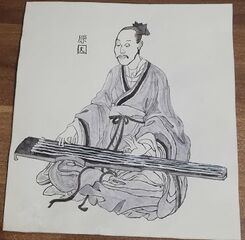Istrian Arts
The Istrian Arts Culture is a important part of the Istrian Evolution. This was the subject of a variate number of controvercies and polemics. It started with the Asian Culture influenceing the paint-makers in the Istrian region in 1935. They saw the Asian culture as a symbolistic representation of the human virtues, and they represented it as best as they could. This determined number of painters to do their art as controvertic as they could.
The Asian Influence
The Asian Influence started when the painter "Jamino Otakasi" came to Istria to promote it's sumi-e paintings. That inspired many painters who later stayed with hours trying to do the work of Jamino. This made it a popular inspirational and aspirational trait that it's seen today thru the simple, or more complicated, sumi-e, that are simple representation of the fellings of the painter who dedicated it's time and devotement to the work.
Reason(原因)

This is the oldest sumi-e discovered on the teritory of Istria. It was painted in ink by an unknown author and depicts a chinese monk playing at a guqin, a traditional chinese instrument. It's called reason because, as the name states, the author had a motivation at the time to paint a so detailed sumi-e that depicts this great representation of calm and concentration.
The right hand represents the devine and the left one the concentration over the art of playing guquin. This monk, was represented staying in a profile position, with no other source of keeping the guquin, representing it's desire of privacy, that isn't respected by the observer.
It's robe is a unique one, one that is rareley seen in monks, that is in general robed in official ceremonies. That represents the fact that every man can be special in it's privacy, but not so many can stand out from the crowd.
However, the monk depicted in the painting stands out of the crowd, haveing the talent of playing the guquin that is so rare in chinese culture. This makes him the most important from it's monk group.
This painting rests now in the Istrian Art Galery, from the National History Museum "Comp I", from Histren.
The Istrian Rennaisance
This movement belived that classical art can and needs to be made in Istria. Thru symbols and other important practicies, this movement became popular between artists of the Kingdom. That gave them the inspiration and cultural progress to make works of arts like the one presented at the National Museum "Comp I".
Agnes Florance

This is the most important work of art of the Istrian Rennaisance. It depicts Dame Agnes Florence, who ordered a portrait of herself to the Painter Louis Carl Alexandrescu. This painting is special because it has a historical importence but also because it depicts a symbolism present rareley in the Istrian Culture.
It first of all presents a dark shadow over the dames face that symbolises the two lives that she was haveing. A later research will unvail that the dame had an intimate relationship with a Duck of Hamburg while her husband was on his death bed.
The background also indicates something about her soul. The painter made it gray and ambiguous, representing the soul of Dame Agnes Florence who was starring in the right thinking about all the bad she has done, all the cheating, all the slutery. She was depicted beautiful and uncounciousley important, the background serveing as a power factor to her importance.
Her vail was made blue, although her ceremonial vail was red. This represented the hope that Florence's family still had about the haritage of the family, her husband leaving her without any child.
See Also
 |
General topics
Flag • Coat of Arms • Istrian Declaration of Independence • Awards and decorations • Hamburg • The Crown Jewels • Istrian Dinar • Kingdom of Istria Politics
Law Enforcement, Defence, and Civil Defence
Culture
|
|---|